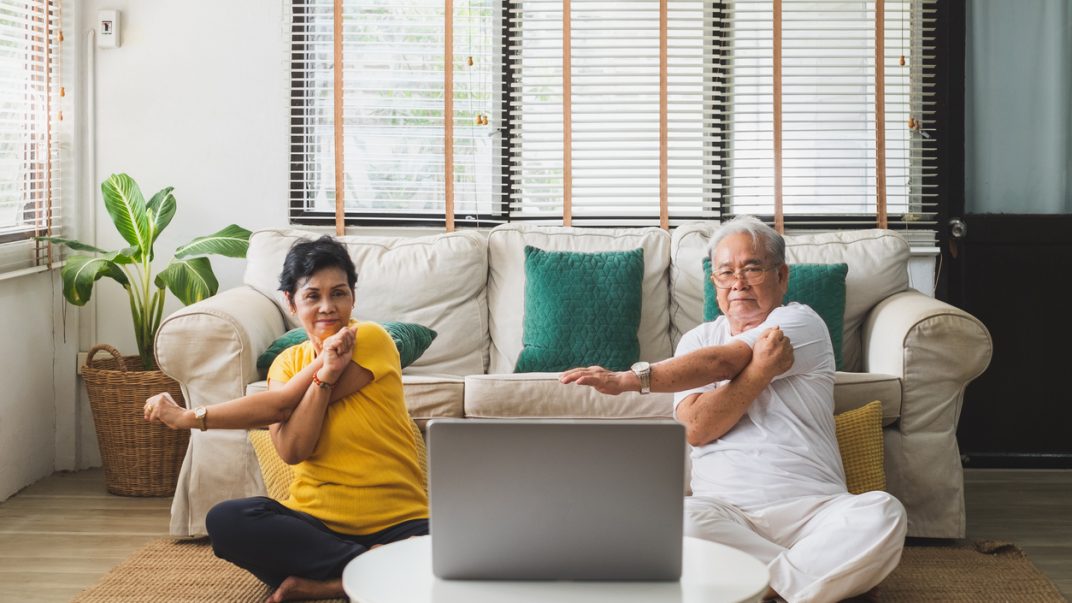Exercising at home: Can digital technologies help?


- Exercise can occur in various locations, from parks to gyms to our homes.
- Home-based exercise delivered through digital technologies can enhance physical function in older adults living in the community.
- Interested in exercising at home? Consult your healthcare team about how to incorporate a home-based exercise program that leverages digital technologies.
Parks, beaches, health and fitness facilities, and home. Can you name a common link between these locations? If you said, “places one can go to relax or have fun,” you would not be wrong. However, while they may be similar in multiple ways, one meaningful connection is that they are all places where we exercise. Access the Canadian 24-Hour Movement Guidelines to learn more about recommended levels of physical activity for older adults (1).
As we go through life, we are sometimes faced with unexpected hurdles or even changes in our preferences that can impact if and how we exercise. Be it global pandemics that lead to lockdowns, issues related to mobility, finances, and access, or simply enjoying the comfort of being in our own house, a strong case for the benefits of home-based exercise can be made.
With the help of digital technologies, exercising at home has never been easier. But is this seemingly dynamic duo effective? One systematic review examined the impacts of home-based exercise programs delivered via digital technologies on outcomes like physical function, quality of life, falls, mobility, and balance in older adults living in the community (2).
What the research tells us
Within the review, older adults engaged in home-based exercise programs that involved one or more of the following: strength exercises, balance exercises, endurance exercises, or physical activity incentives such as counseling or advice. These programs were carried out with the support of digital technologies such as websites, mobile apps, DVDs, videogames, phone calls, videoconferences, and virtual characters or agents. Participants also received feedback automatically, through communication with a therapist, or though the support of a home helper.
The review found that home-based exercise programs delivered via digital technologies can hold several benefits!
Overall, the evidence showed that this combined strategy could enhance physical function, specifically lower limb muscle strength and functional capacity, as well as health-related quality of life in older adults living in the community. The number of falls that this population experienced also decreased. Finally, we saw some additional benefits for older adults living with diseases compared to their healthy counterparts. These included potential improvements in balance and mobility (2).
Getting an adequate amount of exercise is important to optimal aging. If you are struggling to incorporate exercise into your daily or weekly routine, speak with your healthcare team about potential barriers and how to overcome them, as well as home-based exercise that leverages digital technologies. Together, you can develop a plan that includes goals and specifies exercise types, considers safety, and outlines monitoring and follow-up options.
References
- ParticipACTION. Canadian 24-hour movement guidelines for adults (aged 65 years or older). [Internet] 2023. [cited April 2023]. Available from https://www.participaction.com/wp-content/uploads/2022/08/24HMovementGuidelines-ENG-Adults-65-Final.pdf
- Solis-Navarro L, Gismero A, Fernandez-Jane C, et al. Effectiveness of home-based exercise delivered by digital health in older adults: A systematic review and meta-analysis. Age Ageing. 2022; 51(11):afac243. doi: 10.1093/ageing/afac243.
McMaster Optimal Aging Blog Posts are written by faculty, staff, PhD students, and external collaborators, and are assessed for accuracy by members of the Portal scientific leadership team.
DISCLAIMER: These summaries are provided for informational purposes only. They are not a substitute for advice from your own health care professional. The summaries may be reproduced for not-for-profit educational purposes only. Any other uses must be approved by the McMaster Optimal Aging Portal (info@mcmasteroptimalaging.org)